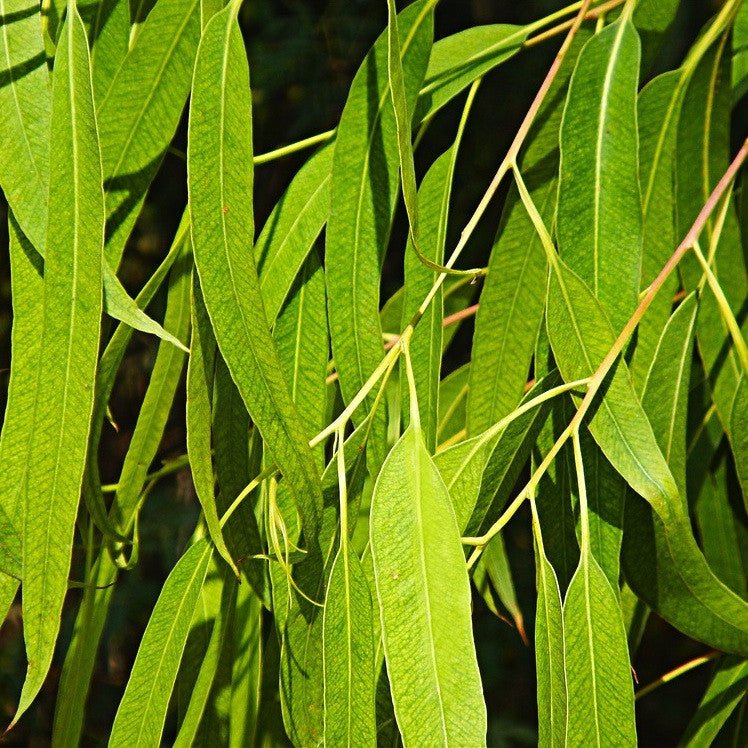TIMELESS Essential Oils
Eucalyptus Radiata, Organic
Couldn't load pickup availability
Pure, Therapeutic Eucalyptus Radiata essential oil, also called Narrow Leafed Peppermint, Organically Grown
Product Details
Botanical name
Eucalyptus radiata
Extraction method / Source
Steam distillation of the leaves
Aroma
Pungent eucalyptus odor
Note classification
Top
Odor Intensity
5
Key constituents
1.8 Cineole (65-70%), Alpha Pinene, Limonene
Plant description
Botanical family: Myrtacaceae
Indigenous to Australia, Eucalyptus radiata is a deciduous tree commonly known as Narrow Leafed Peppermint. The tree grows 90-150 feet in height and produces long glossy green leaves and soft yellow flowers. The gray-brown bark sheds in long, fibrous ribbons. It is now grown commercially in some parts of Africa.
Regions of Production
South Africa
Growing Practices
Organically farmed. Leaves are tested for purity after harvesting.
History / Fun Facts
Eucalyptus Radiata is one of several Eucalyptus trees which were introduced to some parts of Africa to combat malaria. Presence of the trees in large numbers repels many insects, and in particular the mosquitoes which are carriers of malaria. The trees are now also grown commercially.
Properties
Analgesic, antibacterial, anti-inflammatory, anti-neuralgic, antirheumatic, antiseptic, antispasmodic, antiviral, astringent, balsamic, cicatrisant, decongestant, deodorant, diuretic, expectorant, febrifuge, hypoglycemic, rubefacient, vermifuge, vulnerary (Battaglia, 2003).
Please refer to the Glossary for terms which may be new to you.
Uses / Benefits
Fragrant influences
Energizing, clears the mind. Promotes a sense of well being, purification, freedom.
Modes of Administration
Topical: Add to carrier oil or lotion for massage of sore muscles, Dilute with carrier and apply to upper lip or chest to relieve congestion
Inhalation: Diffusion, Direct inhalation, often used in a nasal inhaler
Blends well with
Pine, Thyme, Lavender, Rosemary, Marjoram, Cedarwood, Lemon.
Safety
Not for internal use. Non-toxic, non-irritating, non-sensitizing. Avoid if you are pregnant or breastfeeding, if you are epileptic, or if you have high blood pressure.
Notice
This information is for educational purposes only. It has not been evaluated by the US Food and Drug Administration. It is not intended to diagnose, treat, cure or prevent any condition or disease. Although we strive to provide information which is accurate and up to date, we cannot guarantee the accuracy or completeness of this information.
Precautions
Pure essential oils are highly concentrated plant extracts. Do not use them undiluted, or in the eyes or mucus membranes. If applying an essential oil to the skin, always dilute it with a proper carrier oil and test on a small patch of skin before applying to a large area. Do not take them internally except under the direction of a qualified professional trained in Aromatherapy. Always familiarize yourself with the safety, contraindications and proper preparation of each essential oil before use. Note that when using essential oils for children and the elderly, very low concentrations should be used. Keep all essential oils away from children and pets.
References
Althea Press, Essential Oils: Natural Remedies, 2015. Althea Press, Berkeley, CA.
Battaglia, Salvatore, The Complete Guide to Aromatherapy, Second Edition, 2003. The International Centre of Holistic Aromatherapy, Brisbane, Australia
Cooksley, Valerie Gennari, Aromatherapy: Soothing Remedies to Restore, Rejuvenate, and Heal, 2002. Prentice Hall Press, New York, NY.
Cooksley, Valerie Gennari, Aromatherapy: A Holistic Guide to Natural Healing with Essential Oils, 2015. Floramed Publishing, The Woodlands, TX.
International Fragrance Research Association, http://www.ifraorg.org/en-us/standards (January 5, 2016)
Schnaubelt, Kurt, The Healing Intelligence of Essential Oils: The Science of Aromatherapy, 2011. Healing Arts Press, Rochester, VT.
Tourles, Stephanie L, Hands On Healing Remedies, 2012. Storey Publishing, North Adams, MA.
United States Food and Drug Administration, HHS, 182.1 Substances That Are Generally Recognized as Safe, 182.20 Essential oils, Oleoresins (solvent-free), and natural extractives (including distillates), http://www.gpo.gov/fdsys/CFR-2012-title21-vol3-sec182 (January 28, 2016)
TIMELESS Essential Oils guarantees the purity and quality of all our therapeutic oils. The current Certificate of Analysis is available upon request. All essential oils are best stored in an airtight container away from heat and light.


